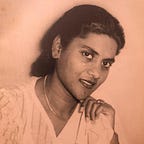How an Anti-Apartheid Activist hid in my Grandfather’s outhouse.
Living in South Africa has always been a constant battle, especially since the 1940s. People were fighting for their fundamental human rights. Activists were dying at the hands of a brutal regime only meant to oppress people of colour. People who retaliated were hunted viciously by the South African Police. An essential activist to the movement was Dr Monty Naicker. Here is a timeline of his political journey and how he landed up hiding from the apartheid police in a little shelter in Umkomaas.
Monty Naicker was born Gangathura Mohambry “Monty” Naicker in 1910 in Kwa-Zulu Natal. His family arrived from India as his grandfather came as a contract labourer. He left South Africa at the age of 18 to study medicine at the University of Edinburgh. In 1934, He returned to South Africa. This marks the beginning of his remarkable career in activism.
While establishing a medical practice in Durban, Dr Monty Naicker started the Hindu Youth Movement. This organisation focused on sports with Indian youths. Most of his patients were poor Indians. He felt a need to help his patients beyond the examination room.
In 1940, he joined the Liberal Study Group. It was an interracial organisation that focused on radical ideology. His political career formally started in 1941 when he became involved in the Indian trade union movement. This was a movement against the government restrictions against Indians owning land. His activism was fuelled more when the apartheid regime came into existence and reinforced these laws.
In 1945, Dr Monty Naicker joined the NIC (National Indian Congress). Eventually, he became the president of the organisation. During 1946, He joined the National Indian Passive Resistance Campaign against Ghetto act (1946) that stop Indians from owning land. He went on to be involved politically in other facets. 1952 was the year he teamed up with ANC president (at the time), Albert Luthuli, in a march against “whites only areas”. He was arrested during this demonstration. This movement was called the “Defiance Campaign” against the authoritarian rule.
Due to his resistance against the apartheid government, he was arrested quite often. He was so active in politicals that the apartheid government wanted to stop his activity. He was banned from attending political meetings during this time. He was closely watched and monitored by SAP (South African Police). He was accused of treason between 1956 to 1961. However, the charges were dropped. He was still watched like a hawk by SAP. He was forced into hiding during these times.
He sought refuge in my grandfather, Mr C.S. Naidoo (Chinniah Swaraja Naidoo). You see, my paternal grandfather was friends with Dr Monty Naicker and would support the NIC during the resistance. To hide from the police, Naicker ran away 50km down the coast of Kwa-Zulu Natal to Umkomaas. My paternal family are from Umkomaas, a small town on the South Coast of Kwa-Zulu Natal. Near his house, my grandfather had a small house constructed out of stone on his property. He hid for quite a few months. Dr Monty Naicker hid until the charges against him were dropped. The little house is still there today. That part of the property became part of my dad’s late brother’s hotel, The Orissa Inn. It is occupied at the moment but still has substantial historical value.
Dr Monty Naicker’s wife was also involved in politicals. Naicker eventually slowed down in his political career after being arrested and banned multiple times. He did give up but rather adopted Mahatma Gandhi’s passive resistance. Naicker did have a family and children. He married Mariemuthumal Apavoo 1936. Apavoo also lead demonstrators to protest white-only spaces. She also was arrested on this day.
In 1978, Dr Monty Naicker passed away due to a short-term illness. He never lived to see the fruits of labour.
The South African communities have been woven in similar fashions. Our stories are connected, especially in times of trouble. The Story of Monty Naicker’s is a story many activists: He persisted through the wrath of the oppressive regime he was forced to live under.
